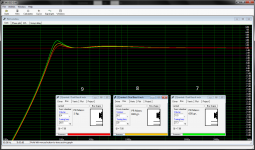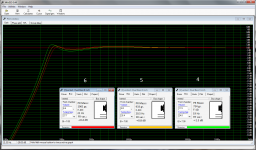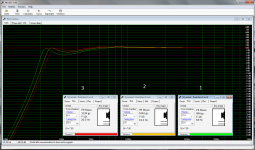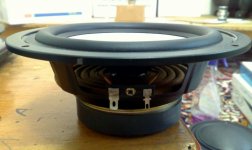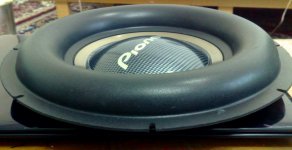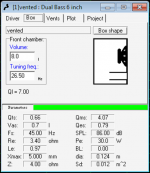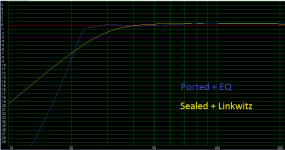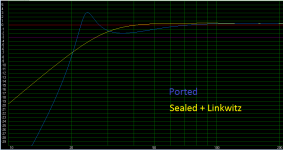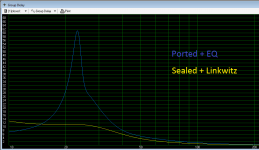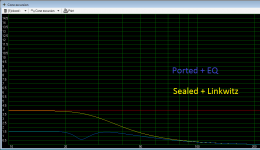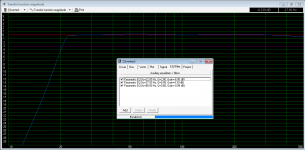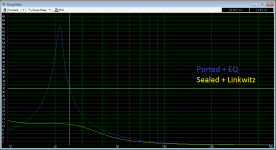Hello to all.
I’m kind of lost designing a PR sub;
With a pair of 6.5” woofers and a 12” Subwoofer replacement cone, I want to make some mini passive radiator subwoofer. Here are my priorities (Most important first):
1- I’m not really into SPL, and also I want to match my subwoofer to my 2.5” mini mains. So I’m going with a flat response down to the mid 20’s, as opposed to a “single note” subwoofer.
2- I’m really sensitive to time response of the subwoofer. The lower the “delay hump” the better, both in frequency and magnitude. Tight, clean and deep bass is my favorite.
3- I use the subwoofer for both HT and music, but I like it more to be musically perfect.
4- The smaller the box size the better. I want to get some “Wow” factor.
And the conditions I have to consider are:
1- Due to physical limits, I have to choose between 6.4L to 11.5L of internal box volume.
2- The PR is very stiff and it’s the only option I have. It’s heavy duty, though, and it can handle huge mass without deforming.
And I came up to these questions, which I didn’t find answered on the net:
1- Can the considerable stiffness of the PR degrade the FR other than reducing the output by a decibel or two? Is there any way to reducing the stiffness – oil or something?
2- Some of the simulations I ran suggest that I use some 1.4Kg of weight on my PR. Should I do that? Notice the PR.
3- For the same tuning frequency, would you suggest a big box with less weight, or a small box with more weight? IMHO, a bigger box goes deeper with less weight, but its response is peakier and has worse time response. is that true?
4- My woofer’s Fs is 45Hz. With the tuning down to the 20’s, am I pushing it too far?
5- How much stuffing should I use? Considering a small box and a bandwidth of 25-250Hz, is a light lining using fiberglass enough?
6- As I’m simulating the PR using the equivalent ported box design in WinISD, is there anything I should consider other than the PR null and the huge delay there?
I guess that the null should happen half an octave lower than the tuning frequency, somewhere near the F-10 point on the ported equivalent. Am I right?
7- Between the curves of 1 to 9 in the attached photos, which one would you choose in your audiophile taste? Which one is more applicable?
Sorry for the long post – Any idea is welcome
Thanks in advance - Ali
I’m kind of lost designing a PR sub;
With a pair of 6.5” woofers and a 12” Subwoofer replacement cone, I want to make some mini passive radiator subwoofer. Here are my priorities (Most important first):
1- I’m not really into SPL, and also I want to match my subwoofer to my 2.5” mini mains. So I’m going with a flat response down to the mid 20’s, as opposed to a “single note” subwoofer.
2- I’m really sensitive to time response of the subwoofer. The lower the “delay hump” the better, both in frequency and magnitude. Tight, clean and deep bass is my favorite.
3- I use the subwoofer for both HT and music, but I like it more to be musically perfect.
4- The smaller the box size the better. I want to get some “Wow” factor.
And the conditions I have to consider are:
1- Due to physical limits, I have to choose between 6.4L to 11.5L of internal box volume.
2- The PR is very stiff and it’s the only option I have. It’s heavy duty, though, and it can handle huge mass without deforming.
And I came up to these questions, which I didn’t find answered on the net:
1- Can the considerable stiffness of the PR degrade the FR other than reducing the output by a decibel or two? Is there any way to reducing the stiffness – oil or something?
2- Some of the simulations I ran suggest that I use some 1.4Kg of weight on my PR. Should I do that? Notice the PR.
3- For the same tuning frequency, would you suggest a big box with less weight, or a small box with more weight? IMHO, a bigger box goes deeper with less weight, but its response is peakier and has worse time response. is that true?
4- My woofer’s Fs is 45Hz. With the tuning down to the 20’s, am I pushing it too far?
5- How much stuffing should I use? Considering a small box and a bandwidth of 25-250Hz, is a light lining using fiberglass enough?
6- As I’m simulating the PR using the equivalent ported box design in WinISD, is there anything I should consider other than the PR null and the huge delay there?
I guess that the null should happen half an octave lower than the tuning frequency, somewhere near the F-10 point on the ported equivalent. Am I right?
7- Between the curves of 1 to 9 in the attached photos, which one would you choose in your audiophile taste? Which one is more applicable?
Sorry for the long post – Any idea is welcome
Thanks in advance - Ali
Attachments
If your goal is for best transient response, go without the PR, and eq one or two actual drivers. PR does take time to start and stop.
Extension is my other goal, so I can't go with the sealed. and I'll lose a lot of power handling using an EQ'd sealed box.
Your statement is true in general, but I heard that PR's can get good transient response if designed properly. I just need to get the untold key factor which makes one design "Proper" in terms of transient response. I think it's somehow related to the compromise between the box size and the PR weight.
And PR's do make the box smaller, and yes they do go deeper, both characteristics I really like to have.
PS: Size is another factor; otherwise I would have gone the TH or T-line way, as with my tiny mains:
http://www.diyaudio.com/forums/full-range/65061-full-range-speaker-photo-gallery-368.html
Regards - Ali
Last edited:
Like any bass reflex cabinet, PR is a resonator, and will cause more group delay. Your box, your choice of compromise....
Yes, I believe I'm not going any more tight than a sealed box here.
But PR is my only design of choice, due to my limitations.
I guess I just need a better simulation software - in which I can observe the group delay and PR null in person (!) not just by guesstimating. Without it, I'm lost. Please take a look at the plots 1 to 10. I don't know which one to pick, just because I don't know which gives better transient response.
Like any bass reflex cabinet, PR is a resonator, and will cause more group delay. Your box, your choice of compromise....
In the following experiment by Data-Bass, no major shortcoming is seen in the PR decay time except for certain frequencies. But everyone is stating that a PR is far less transient - perfect. What's the deal?
Data-Bass
OK, now I measured the PR parameters as follows:
Cms = 6.954 e-6
Vas = 1.418 lit.
Fs = 24 Hz
But how about the Qms parameter? in one of the threads one suggested that I just need to use Qms = 5 for modeling.
In my case with such stiff PR, do I have to input a much lower value, say, 3 for my calculations?
Cms = 6.954 e-6
Vas = 1.418 lit.
Fs = 24 Hz
But how about the Qms parameter? in one of the threads one suggested that I just need to use Qms = 5 for modeling.
In my case with such stiff PR, do I have to input a much lower value, say, 3 for my calculations?
Hi 4392Viper,
In Post #1 you show a WinISD picture with Vas: 0.7 L, that does not look correct. In Post #7 you have a Vas (maybe Vap would be better to reduce confusion?)=1.418 L, that also does not look correct; and the Cms (Cmp) for the passive doesn't look right either.
I recommend you verify your T/S parameters, at least measure the parameters of your woofer. If this isn't correct the rest will also be wrong.
Post #5: "...I guess I just need a better simulation software..."
Give Hornesp a try. It's also free, and David McBean has added an 'Input Wizard' under Help which can get you started quickly.
Regards,
In Post #1 you show a WinISD picture with Vas: 0.7 L, that does not look correct. In Post #7 you have a Vas (maybe Vap would be better to reduce confusion?)=1.418 L, that also does not look correct; and the Cms (Cmp) for the passive doesn't look right either.
I recommend you verify your T/S parameters, at least measure the parameters of your woofer. If this isn't correct the rest will also be wrong.
Post #5: "...I guess I just need a better simulation software..."
Give Hornesp a try. It's also free, and David McBean has added an 'Input Wizard' under Help which can get you started quickly.
Regards,
Thanks for input, tb46.
0.7 is my active driver's Vas. I agree it doesn't seem correct or usual, but it's what I came to using this link:
T-S Parameter Calculator
And the Vas of the PR that I calculated, too.
I've now downloaded the latest version of WinISD, but I'll try Hornresp too. but First I have to find a way to measure my stuff corectly. I don't know where am I making this huge mistake.
Regards, Ali
0.7 is my active driver's Vas. I agree it doesn't seem correct or usual, but it's what I came to using this link:
T-S Parameter Calculator
And the Vas of the PR that I calculated, too.
I've now downloaded the latest version of WinISD, but I'll try Hornresp too. but First I have to find a way to measure my stuff corectly. I don't know where am I making this huge mistake.
Regards, Ali
Last edited:
The 'passive radiator' you have there is most likely just a car subwoofer chassis without a magnet. They are made for extremely high excursion and low to extremely low needed volume.
There ain't no such thing as a free lunch.
These things cost you, because of the needed parameters they have a extremely high moving mass, very stiff suspension, very high mechanical losses. That means, they are slow, they don't follow subtle impulses because they are 'eaten up' by the huge mechanical losses, they only start to work properly at higher spl.
Or in other words: Your PR isn't suited for your goals, you can't make a cake out of potatoes. It will not sound as you want it to.
You don't believe me? Well, no problem, no need to discuss that further. Why? Your project won't work out because you can't fit 2x 6,5" and a 12" within a that tiny volume. At 11,5l you have the PR on one side and the 2 (sub-)woofers on the other side, if you make the 2 woofers fit on the surface, you'll have around 85mm depth left. Your woofers aren't deeper (from the picture one might doubt that)? Nice. But they will still collide with the passive membrane basket.
There ain't no such thing as a free lunch.
These things cost you, because of the needed parameters they have a extremely high moving mass, very stiff suspension, very high mechanical losses. That means, they are slow, they don't follow subtle impulses because they are 'eaten up' by the huge mechanical losses, they only start to work properly at higher spl.
Or in other words: Your PR isn't suited for your goals, you can't make a cake out of potatoes. It will not sound as you want it to.
You don't believe me? Well, no problem, no need to discuss that further. Why? Your project won't work out because you can't fit 2x 6,5" and a 12" within a that tiny volume. At 11,5l you have the PR on one side and the 2 (sub-)woofers on the other side, if you make the 2 woofers fit on the surface, you'll have around 85mm depth left. Your woofers aren't deeper (from the picture one might doubt that)? Nice. But they will still collide with the passive membrane basket.
In the following experiment by Data-Bass, no major shortcoming is seen in the PR decay time except for certain frequencies. But everyone is stating that a PR is far less transient - perfect. What's the deal?
Data-Bass
I am not convinced this test you linked to yields any useful information.
I suspect that eqing the driver to produce the same sealed box response in all cabs eq's away any potential problems that may be caused by the PR.
Also the PR appears to be tuned extremely low (10-12Hz for a woofer with an Fs of 30Hz) meaning it is so low that it will not do much at all.
Well, a traditional BR won't work either. You have such extreme parameter, your port will be most likely 1-2m long at 4cm diameter. I don't know how you wanted to shape your enclosure but I don't think that port will fit well (at all) into the enclosure. Even if you fold the port several times (=high losses) it makes your box a LOT bigger. Besides that your will get length-resonance. A smaller diameter (to make the port shorter) isn't recommended either since it introduces air flow noise and compression.
I've had again a look at the parameters of the woofer. A Qts of 0,66 or 0,7 seems to me a lot too high for a ported box (the parameters still don't seam reasonable to me either). A sealed box would be fine, a transmissionline or QTWT would probably work too but both would become a lot bigger.
If these parameters are really correct, I'd suggest you'd sell these chassis (or use them for another project) and get some more suitable for ported enclosures.
I've had again a look at the parameters of the woofer. A Qts of 0,66 or 0,7 seems to me a lot too high for a ported box (the parameters still don't seam reasonable to me either). A sealed box would be fine, a transmissionline or QTWT would probably work too but both would become a lot bigger.
If these parameters are really correct, I'd suggest you'd sell these chassis (or use them for another project) and get some more suitable for ported enclosures.
Thank you ICG, Charles Darwin, for input.
I left the woofer playing "Bassotronics" for half an hour, double - checked all the stuff and then repeated the measurement. No major differences. still the Qts of 0.6 , still the Vas of 0.67L.
But now when I input the new numbers in the WinISD... It says that there's an inconsistency in the numbers! It automatically corrects the speaker diameter from 12.4 cm (original) to 6 cm. WHY??!
I let go of the automatically generated number and compared the new FR graph to the old one: only half a decibel lower in level and a little bit peakier low-end. I only hope the numbers be close enough to reality, as I don't have any other means of measurements, nor any headroom for another driver.
ICG, The ported box will be like this: 20* 20* 50 cm making up an internal volume of 20 liters. I put the drivers on one 20* 50 side, and a 45 cm port on one 20* 20 side. Port diameter will be 4.7 cm, which is least acceptable, yet working. This gives us the curve in the first picture (Blue), which I believe is quite acceptable with a little EQ'ing.
Charles Darwin, I applied the Linkwitz transform to the sealed and guess what happened? The woofer couldn't stand a single watt and hit the Xmax very quick. The graph below is the sealed (yellow) plus the Linkwitz transform. The one applied here is the best one so that the driver doesn't hit the Xmax at one watt. Though it's quite impractical to build IMHO. The ported one, though, is capable of 10 watts befrore exceeding the Xmax, which is probably more than where I want to go usually.
As for group delay, The sealed does much better, but still it doesn't convince me to make it sealed.
I think the ported will do better for me. Only if I can find a way to reduce its group delay a little. How much can stuffing help me?
Regards, Ali
I left the woofer playing "Bassotronics" for half an hour, double - checked all the stuff and then repeated the measurement. No major differences. still the Qts of 0.6 , still the Vas of 0.67L.
But now when I input the new numbers in the WinISD... It says that there's an inconsistency in the numbers! It automatically corrects the speaker diameter from 12.4 cm (original) to 6 cm. WHY??!
I let go of the automatically generated number and compared the new FR graph to the old one: only half a decibel lower in level and a little bit peakier low-end. I only hope the numbers be close enough to reality, as I don't have any other means of measurements, nor any headroom for another driver.
ICG, The ported box will be like this: 20* 20* 50 cm making up an internal volume of 20 liters. I put the drivers on one 20* 50 side, and a 45 cm port on one 20* 20 side. Port diameter will be 4.7 cm, which is least acceptable, yet working. This gives us the curve in the first picture (Blue), which I believe is quite acceptable with a little EQ'ing.
Charles Darwin, I applied the Linkwitz transform to the sealed and guess what happened? The woofer couldn't stand a single watt and hit the Xmax very quick. The graph below is the sealed (yellow) plus the Linkwitz transform. The one applied here is the best one so that the driver doesn't hit the Xmax at one watt. Though it's quite impractical to build IMHO. The ported one, though, is capable of 10 watts befrore exceeding the Xmax, which is probably more than where I want to go usually.
As for group delay, The sealed does much better, but still it doesn't convince me to make it sealed.
I think the ported will do better for me. Only if I can find a way to reduce its group delay a little. How much can stuffing help me?
Regards, Ali
Attachments
Last edited:
New update!
Box: 18.5L (1.5L occupied by drivers, power supply etc.)
3* Parametric EQ, which I will later apply through my computer. The EQ's seem reasonable as they won't damage my mini full-range mains which are not crossed-over. And they don't need any more circuitry (as with the Linkwitz transform).
The FR variation is now under -+ 0.1dB on the paper.
The Group delay is 63 ms @ 21 Hz and is under 40 ms down to 23 Hz, which is IMHO fairly low in frequency to be audible or annoying.
Cone excursion is in the usable range up to 17 watts per driver, which is fairly acceptable.
Regards, Ali
Box: 18.5L (1.5L occupied by drivers, power supply etc.)
3* Parametric EQ, which I will later apply through my computer. The EQ's seem reasonable as they won't damage my mini full-range mains which are not crossed-over. And they don't need any more circuitry (as with the Linkwitz transform).
The FR variation is now under -+ 0.1dB on the paper.
The Group delay is 63 ms @ 21 Hz and is under 40 ms down to 23 Hz, which is IMHO fairly low in frequency to be audible or annoying.
Cone excursion is in the usable range up to 17 watts per driver, which is fairly acceptable.
Regards, Ali
Attachments
Last edited:
That's the reason I'm not a fan of the Linkwitz Transform thing: It wastes power and excursion.
But it seems you've found the best compromise so all is well that ends well I suppose!
As for passive radiators being worse than bass reflex this is not surprising.
Both systems work by having the driven woofer coupled to a resonator via the internal volume of air.
In the case of BR the resonator is the air column in the port tube and this weighs 1g or less while a passive radiator weighs 30g+.
But it seems you've found the best compromise so all is well that ends well I suppose!
As for passive radiators being worse than bass reflex this is not surprising.
Both systems work by having the driven woofer coupled to a resonator via the internal volume of air.
In the case of BR the resonator is the air column in the port tube and this weighs 1g or less while a passive radiator weighs 30g+.
My Conclusion
I was actually surprised of how much power it wasted to recover the FR - I couldn't match a 60W amp and a pair of long-throw woofers to my 2* 2.5W mains!
The reason being: My subwoofer amp is roughly 10 times more powerful than my main amp. So there's a 10dB headroom for FR adjustment. but the sealed introduced more than -15dB @25 Hz, so I couldn't provide enough power - let alone the cone excursion beast!
I guess so, thank you all for sharing your brilliant ideas. So let's wrap it up:
Based on what I read on the net, I first chose PR because I thought PR was:
---more reliable and easier to tune,
---smaller in size and equal in efficiency,
---safer for woofer excursion,
---better transient-perfect,
than usual BR.
But what I faced was a design which was:
---much more complicated to tune,
---introducing gigantic amounts of weights,
---very uneven in FR, group delay and excursion curves and very inefficient.
What I learned from the PR:
---Match your PR's free air resonance to your active driver's Fs. In my case, the two resonances were near an octave apart (45 Hz - 24 Hz) and so it didn't work no matter how much weight I added to my drivers.
---Your PR has to be looser i.e. it has to have more compliance than your active driver. My PR was 10 times less compliant than my woofers, so I didn't get any efficiency, nor any excursion control. It was behaving much like a sealed box.
---Have an eye on your Vas, Vap, and Vb. In my case, my box size was too big compared to my Vas, that it produced peaky FR curves, yet too small (compared to my PR's Sd) to give me reasonable PR weights. I always came up with 1Kg or so.
---Get yourself a good simulating software and don't get fooled; PR is NOT like bass reflex. Don't base your projects on bass reflex simulations!
---Finally, Don't pick a random PR. It's impossible to match it to your woofers. PR's are pretty much tolerant for weight, but Vap, Qmp and Cmp are all parameters that can get you totally messed up!
And for the sealed, I learned that sealed mid-bass may be a perfect choice, but sealed subwoofer is not practical unless you are generous ( and by generous I mean really generous!) on the stuff. It's like you put a 300W amp and a long-throw 12 inch subwoofer, plus a heavy Linkwitz transform to match a pair of laptop speakers! (of course if you want a flat response down to 20's ) and even then, the transient response won't be as good as an 'untouched' sealed.
Of course the final design I came to showed pretty good group delay characteristics down to mid 20's.
Please correct me if I went wrong - Any Ideas appreciated.
Regards, Ali
That's the reason I'm not a fan of the Linkwitz Transform thing: It wastes power and excursion.
I was actually surprised of how much power it wasted to recover the FR - I couldn't match a 60W amp and a pair of long-throw woofers to my 2* 2.5W mains!
The reason being: My subwoofer amp is roughly 10 times more powerful than my main amp. So there's a 10dB headroom for FR adjustment. but the sealed introduced more than -15dB @25 Hz, so I couldn't provide enough power - let alone the cone excursion beast!
...But it seems you've found the best compromise so all is well that ends well I suppose!
I guess so, thank you all for sharing your brilliant ideas. So let's wrap it up:
Based on what I read on the net, I first chose PR because I thought PR was:
---more reliable and easier to tune,
---smaller in size and equal in efficiency,
---safer for woofer excursion,
---better transient-perfect,
than usual BR.
But what I faced was a design which was:
---much more complicated to tune,
---introducing gigantic amounts of weights,
---very uneven in FR, group delay and excursion curves and very inefficient.
What I learned from the PR:
---Match your PR's free air resonance to your active driver's Fs. In my case, the two resonances were near an octave apart (45 Hz - 24 Hz) and so it didn't work no matter how much weight I added to my drivers.
---Your PR has to be looser i.e. it has to have more compliance than your active driver. My PR was 10 times less compliant than my woofers, so I didn't get any efficiency, nor any excursion control. It was behaving much like a sealed box.
---Have an eye on your Vas, Vap, and Vb. In my case, my box size was too big compared to my Vas, that it produced peaky FR curves, yet too small (compared to my PR's Sd) to give me reasonable PR weights. I always came up with 1Kg or so.
---Get yourself a good simulating software and don't get fooled; PR is NOT like bass reflex. Don't base your projects on bass reflex simulations!
---Finally, Don't pick a random PR. It's impossible to match it to your woofers. PR's are pretty much tolerant for weight, but Vap, Qmp and Cmp are all parameters that can get you totally messed up!
And for the sealed, I learned that sealed mid-bass may be a perfect choice, but sealed subwoofer is not practical unless you are generous ( and by generous I mean really generous!) on the stuff. It's like you put a 300W amp and a long-throw 12 inch subwoofer, plus a heavy Linkwitz transform to match a pair of laptop speakers! (of course if you want a flat response down to 20's ) and even then, the transient response won't be as good as an 'untouched' sealed.
Of course the final design I came to showed pretty good group delay characteristics down to mid 20's.
Please correct me if I went wrong - Any Ideas appreciated.
Regards, Ali
Attachments
Last edited:
I think you pretty much nailed Ali although I haven't looked as deeply into PRs as you have by now! ;-)
Thank you! I'll post the updates to my project; although this alignment seems good enough for my purpose.
Only one thing left that I didn't find on the net:
I have two options for the port: two 1.5" paper pipes, or one 2" paper pipe.
Both make up equal surface area and length.
Does one option have some sort of benefit over the other?
Right now using Flare-it! Flare-it - Free Speaker Design Software
Only difference I noticed is that two smaller ports showed much better chuffing tolerance, using the same flare radius.
Both have same resonance, of course.
And what's the minimal distance between the port throat and the opposite panel?
Right now I'm considering a distance of 5 cm (2") and I don't know if it's enough.
Best regards, Ali.
- Status
- This old topic is closed. If you want to reopen this topic, contact a moderator using the "Report Post" button.
- Home
- Loudspeakers
- Subwoofers
- Passive Radiator Compromises
